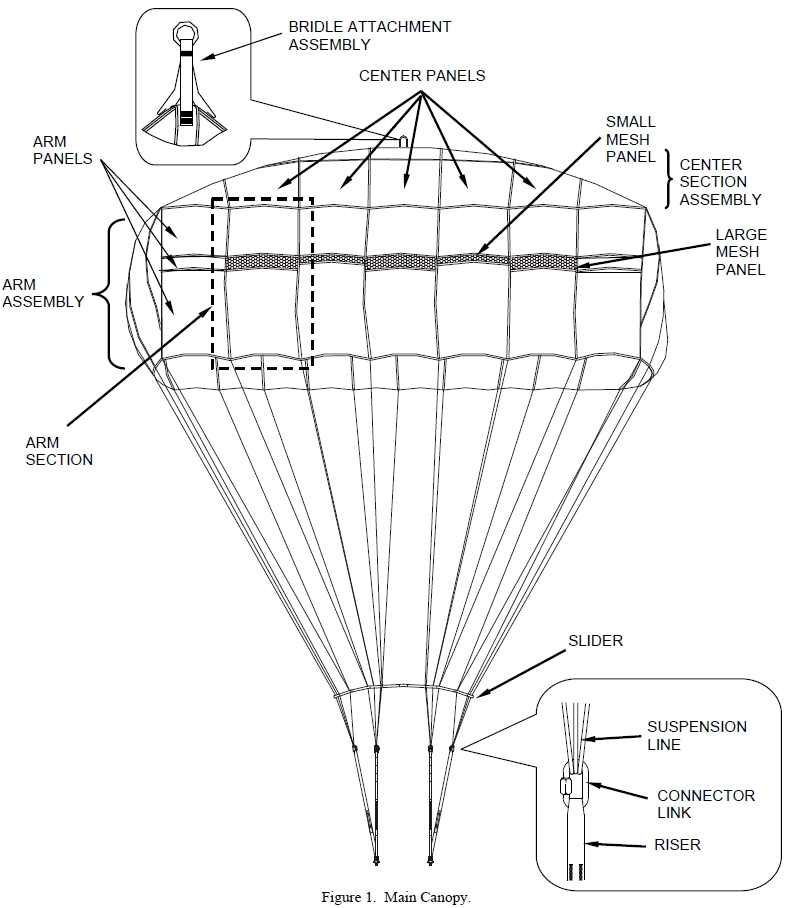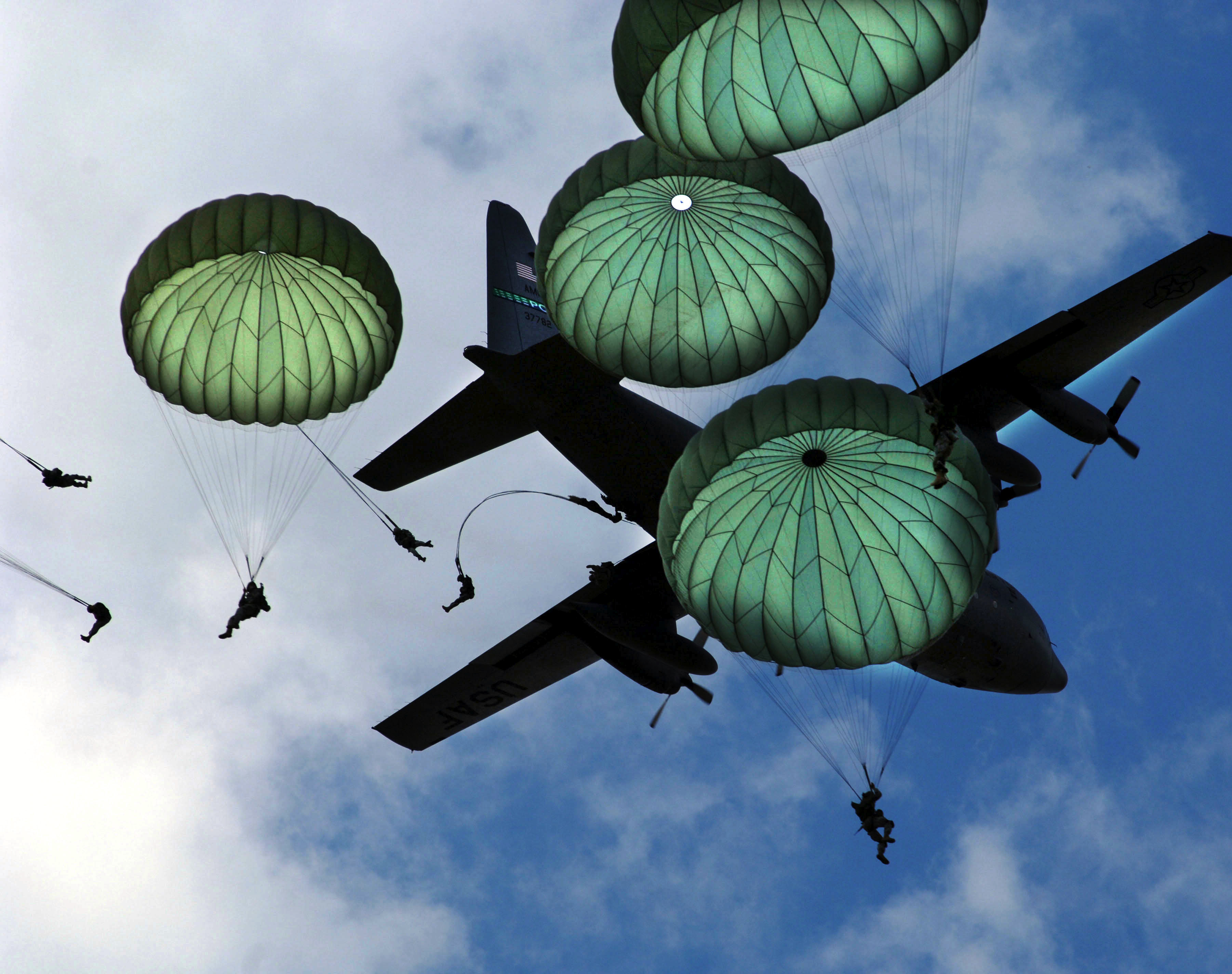|
MC-6 Parachute
The MC-6 Parachute is a ''Maneuverable Canopy'' (MC) static line-deployed personnel parachute of the United States Armed Forces. Developed by United States Army Special Forces, the parachute has been used by American ''Special Operations Forces'' (SOF) beginning in 2006 and Australian SOF starting in 2011. Under an initiative dubbed ''Special Operations Forces Tactical Advanced Parachute System'' (SOFTAPS), intended to provide a replacement for the MC1-1 Parachute, the SF-10A Parachute became an interim successor to the MC1-1 before culminating in the development and production of the MC-6 Parachute. Background In the mid-1990s, as part of the Base Realignment and Closure plan, the 10th Special Forces Group was relocated from Fort Devens, Massachusetts to Fort Carson, Colorado. The altitude of their new garrison at over proved challenging in many ways, not the least of which was that their new higher altitude meant that aircraft stall speeds were somewhat higher than at th ... [...More Info...] [...Related Items...] OR: [Wikipedia] [Google] [Baidu] |
Static Line
A static line is a fixed cord attached to a large, stable object. It is used to open parachutes automatically for paratroopers and novice parachutists. Design and use A static line is a cord attached at one end to the aircraft and at the other end to the top of the jumper's "D-Bag" (deployment bag, into which the canopy is packed). The parachutist's fall from the aircraft causes the static line to become taut, this then pulls the D-Bag out of the container on the jumper's back. The static line and D-Bag stay with the aircraft as the jumper leaves, and are pulled back into the aircraft by the dispatcher. Now free of its D-Bag, the canopy is allowed to inflate as the jumper continues to fall. Effectively, the jumper drags the parachute behind him, causing the upward-rushing wind to force open and inflate the canopy. The canopy should inflate and begin supporting the jumper within four seconds. In the unlikely event of a malfunction, students are taught how to cut away the main c ... [...More Info...] [...Related Items...] OR: [Wikipedia] [Google] [Baidu] |
Parachute Cord
Parachute cord (also paracord or 550 cord when referring to type-III paracord) is a lightweight nylon kernmantle rope originally used in the suspension lines of parachutes. This cord is now used as a general purpose utility cord. This versatile cord was used by astronauts during the 82nd Space Shuttle mission to repair the Hubble Space Telescope. The braided sheath is usually made up of 32 interwoven strands, giving it a relatively smooth texture. The all-nylon construction makes paracord somewhat elastic. Current technical standards for the manufacture of cord for use in parachutes are published by the Parachute Industry Association. The now inactivated US military standard MIL-C-5040H required the material to be nylon. Similar styles of cord are manufactured with other materials such as polyester. Usage Historically associated with airborne units and divisions, paracord is not used as cordage for modern "square" parachutes. However, it continues to be used by many m ... [...More Info...] [...Related Items...] OR: [Wikipedia] [Google] [Baidu] |
Jumpmaster
Jumpmasters are the expert paratroopers in an airborne unit who train and teach the military techniques for jumping from airplanes. They are responsible for training soldiers who enter Army Airborne School into paratroopers and managing airborne jump operations in airborne units across all branches of services. Military In military applications, jumpmasters are used for static line and freefall jumps. Australia In Australia, jumpmasters are formed and used by the 2nd Commandos Regiment. Jumpmasters from the 17th Special Operations Squadron and 2nd Commandos Regiment conduct jump operation exercises to strengthen interoperability relationship between U.S. and Australian special operation forces. Canada In Canada, jumpmaster training is conducted for the Canadian Forces by the Canadian Army Advanced Warfare Centre at CFB Trenton in Trenton, Ontario. The Queen's Own Rifles of Canada is the only Primary Reserve unit with jumpmasters. Typically those selected for training a ... [...More Info...] [...Related Items...] OR: [Wikipedia] [Google] [Baidu] |
T-11 Parachute
The Non-Maneuverable Canopy (T-11) Personnel Parachute System is the newest personnel parachute system to be adopted by the United States armed forces and the Canadian Army. The T-11 replaces the T-10, introduced in 1955. The T-11 includes a completely redesigned main and reserve parachute and an integrated harness assembly that is suitable for a wider range of soldier weights than the previous system. Design The main canopy is a modified version of a cross/cruciform platform. The canopy has an increased inflated diameter of 14 percent and a 28 percent increase in surface area, when compared with the T-10D assembly. The T-11 main canopy utilizes a unique deployment sequence to reduce the opening shock and canopy oscillation. The T-11 is designed to have an average rate of descent of for the 95th percentile service member, compared with with the T-10C. This reduction is intended to result in significantly lower landing injury rates for jumpers. The reserve canopy is a derivat ... [...More Info...] [...Related Items...] OR: [Wikipedia] [Google] [Baidu] |
United States Army Special Operations Command
The United States Army Special Operations Command (Airborne) (USASOC ( )) is the command charged with overseeing the various special operations forces of the United States Army. Headquartered at Fort Bragg, North Carolina, it is the largest component of the United States Special Operations Command. It is an Army Service Component Command. Its mission is to organize, train, educate, man, equip, fund, administer, mobilize, deploy and sustain Army special operations forces to successfully conduct worldwide special operations. Subordinate units 1st Special Forces Command (Airborne) The 1st Special Forces Command (Airborne) is a division-level special operation forces command within the US Army Special Operations Command. The command was established on 30 September 2014, grouping together the Army special forces, psychological operations, civil affairs, and other support troops into a single organization operating out of its new headquarters building at Fort Bragg, NC. S ... [...More Info...] [...Related Items...] OR: [Wikipedia] [Google] [Baidu] |
Program Of Record
The processes of government procurement in the United States enable federal, state and local government bodies in the country to acquire goods, services (including construction), and interests in real property. In fiscal year 2019, the US Federal Government spent $597bn on contracts. Bloomberg GovernmentBGOV200: Federal Industry Leaders 2019 accessed 9 July 2020 The market for state, local, and education (SLED) contracts is thought to be worth $1.5 trillion. Contracts for federal government procurement usually involve appropriated funds spent on supplies, services, and interests in real property by and for the use of the Federal Government through purchase or lease, whether the supplies, services, or interests are already in existence or must be created, developed, demonstrated, and evaluated. Federal Government contracting has the same legal elements as contracting between private parties: a lawful purpose, competent contracting parties, an offer, an acceptance that complies w ... [...More Info...] [...Related Items...] OR: [Wikipedia] [Google] [Baidu] |
T-10 Parachute
The T-10 Parachute is a series of static line-deployed parachutes used by the United States armed forces for combat mass-assault airborne operations and training. The T-10 parachute was introduced in the early 1950s. In 1976, the B model introduced the anti-inversion net; in 1986, the C model was introduced, which changed the pocket band free length from 4" to 7½". The T-10D, adopted in 2000, includes the detachable pack tray, which in itself includes the 15' universal static line and 5' extension static line. The T-10D is currently being replaced by the T-11 parachute system. In 2006, all T-10C parachutes were revised by adding one static line stow bar to each side of the pack tray; the material for the T-10C was also changed to the muddy water 407. Design Depending upon air density and the jumper’s total weight, the parachute’s average rate of descent is from ; total suspended weight limitation is . The parachute is deployed using either a static line, allowing the parach ... [...More Info...] [...Related Items...] OR: [Wikipedia] [Google] [Baidu] |
Smokejumper
Smokejumpers are specially trained wildland firefighters who provide an initial attack response on remote wildland fires. They are inserted at the site of the fire by parachute. In addition to performing the initial attack on wildfires, they may also provide leadership for extended attacks on wildland fires. Shortly after smokejumpers touch ground, they are supplied by parachute with food, water, and firefighting tools, making them self-sufficient for 48 hours. Smokejumpers are usually on duty from early spring through late fall. Smokejumpers worldwide Smokejumpers are employed by the Russian Federation, United States (namely the United States Forest Service and Bureau of Land Management), and Canada (in British Columbia). History Prior to the full establishment of smokejumping, experiments with parachute insertion of firefighters were conducted in 1934 in Utah and in the Soviet Union. Earlier, aviation firefighting experiments had been conducted with air delivery of equip ... [...More Info...] [...Related Items...] OR: [Wikipedia] [Google] [Baidu] |
United States Forest Service
The United States Forest Service (USFS) is an agency of the U.S. Department of Agriculture that administers the nation's 154 national forests and 20 national grasslands. The Forest Service manages of land. Major divisions of the agency include the Chief's Office, National Forest System, State and Private Forestry, Business Operations, and Research and Development. The agency manages about 25% of federal lands and is the only major national land management agency not part of the U.S. Department of the Interior, which manages the National Park Service, the U.S. Fish and Wildlife Service, and the Bureau of Land Management. History The concept of national forests was born from Theodore Roosevelt's conservation group, Boone and Crockett Club, due to concerns regarding Yellowstone National Park beginning as early as 1875. In 1876, Congress formed the office of Special Agent in the Department of Agriculture to assess the quality and conditions of forests in the United S ... [...More Info...] [...Related Items...] OR: [Wikipedia] [Google] [Baidu] |
Commercial Off-the-shelf
Commercial off-the-shelf or commercially available off-the-shelf (COTS) products are packaged or canned (ready-made) hardware or software, which are adapted aftermarket to the needs of the purchasing organization, rather than the commissioning of custom-made, or bespoke, solutions. A related term, Mil-COTS, refers to COTS products for use by the U.S. military. In the context of the U.S. government, the Federal Acquisition Regulation (FAR) has defined "COTS" as a formal term for commercial items, including services, available in the commercial marketplace that can be bought and used under government contract. For example, Microsoft is a COTS software provider. Goods and construction materials may qualify as COTS but bulk cargo does not. Services associated with the commercial items may also qualify as COTS, including installation services, training services, and cloud services. COTS purchases are alternatives to custom software or one-off developments – government-funded de ... [...More Info...] [...Related Items...] OR: [Wikipedia] [Google] [Baidu] |
Drop Zone
A drop zone (DZ) is a place where parachutists or parachuted supplies land. It can be an area targeted for landing by paratroopers, or a base from which recreational parachutists and skydivers take off in aircraft and land under parachutes. In the latter case, it is often beside a small airport, frequently sharing the facility with other general aviation General aviation (GA) is defined by the International Civil Aviation Organization (ICAO) as all civil aviation aircraft operations with the exception of commercial air transport or aerial work, which is defined as specialized aviation service .... At recreational drop zones, an area is generally set side for parachute landings. Personnel at the site may include a drop zone operator or owner (DZO), manifestors (who maintain the flight manifest documents defining who flies and when), pilots, instructors or coaches, camera operators, parachute packers and riggers, and other general staff. History The concept of a drop ... [...More Info...] [...Related Items...] OR: [Wikipedia] [Google] [Baidu] |








